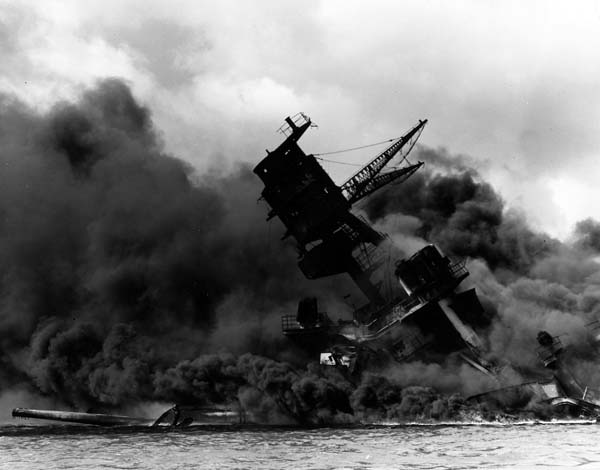West Virginia Remembers Pearl Harbor
By Patricia Richards McClure and Stan Bumgardner

Nearly 1,200 sailors, including five West Virginians, lost their lives aboard the USS Arizona at Pearl Harbor. Courtesy of the National Archives and Records Administration.
It lasted only two hours. Two hours that reshaped American history forever. President Franklin D. Roosevelt immortalized December 7, 1941, as “a date which will live in infamy.”
The Japanese attack on the U.S. naval base at Pearl Harbor, near Honolulu, Hawaii, was devastating to American armed forces. The air assault destroyed nearly 20 naval vessels, including eight battleships, and more than 300 airplanes. Nearly 2,500 U.S. sailors, soldiers, and civilians died in the attack; another 1,000 were wounded. The next day, December 8, the United States joined the world war it had avoided for two years.
In small communities across West Virginia, December 7 dawned bright and sunny, with temperatures from moderate to chilly. Families went to church and then home for their Sunday suppers.
The attack occurred about 7:48 a.m. local time in Hawaii, or 1:48 p.m. Eastern Standard Time. The Associated Press broke the news about a half-hour later. News spread quickly throughout West Virginia—by radio, newspaper, and word of mouth. Front pages hinted that war was looming. Later in the day, a Charleston Daily Mail extra proclaimed what citizens had already learned from their radios: “U.S. at War with Japan; Manila, Hawaii Shelled.”
At least 27 West Virginians are known to have died as a result of the attack on Pearl Harbor. Angle, Barnhart, Browning, Bryant, Carroll, Drwall, Hull, McCloud, McComas, McGraw, Nichols, Reed, Robinson, Skaggs, Thomas, Wilson, Wimmer, Wright. Their surnames represent our state’s diversity at the time.
Robert Paul Laderach—whose grandparents had emigrated from Switzerland in 1880 and relocated to the heart of West Virginia—had entered the service in October 1937, when he was 20. While the young man might have joined the Navy to see the world, he had the misfortune of being on the USS Arizona (BB-39) that fateful morning of December 7. A little more than 10 minutes into the attack, a Japanese bomb hit a powder magazine aboard the Arizona, plummeting the ship to the bottom of the harbor and killing 1,177 men—nearly half of all Americans killed at Pearl Harbor. The battleship was damaged beyond repair and left at the bottom of Pearl Harbor. The USS Arizona Memorial sits on the ship’s hull and is the final resting place of more than 1,000 sailors, including these West Virginians:
- Earnest Hersea Angle, 19, of Quinwood, Greenbrier County, fireman 2nd class
- Tilmon David Browning, 16, of Omar, Logan County, seaman 1st class
- Robert Paul Laderach, 24, of Beverly, Randolph County, fire controlman 2nd class
- Robert Warren Robinson, 19, of Sistersville, Tyler County, patternmaker 2nd class
- Randall James Thomas, 20, of Cowen, Webster County, seaman 1st class
An American of Polish descent, Stanislaw Frank Drwall had worked in the mines at Douglas (now Albert), Tucker County, and enlisted in the Navy four years before his death at Pearl Harbor. Sadly, the war would take another child from Frank and Mary Drwall. Stanislaw’s younger brother Walter was later lost at sea in the North Atlantic. Stanislaw Frank Drwall was one of eight West Virginians who died aboard the USS Oklahoma (BB-37).
Torpedoes struck the Oklahoma just seconds after the attack began. Within 12 minutes, the ship had capsized with her masts resting on the bottom of Pearl Harbor. The sinking of the Oklahoma brought unthinkable news to David and Mary Casto of Chester. Two of their sons, Richard Eugene and Charles Ray, had died on the capsized ship. Among the 429 who perished aboard the Oklahoma were
- Joseph William Carroll, age unknown, of Fairmont, Marion County, fireman 2nd class
- Charles Ray Casto, 21, of Chester, Hancock County, fireman 1st class
- Richard Eugene Casto, 19, of Chester, Hancock County, fireman 2nd class
- Stanislaw Frank Drwall, 25, of Douglas, Tucker County, patternmaker 1st class
- Donald Robert McCloud, 21, of Monaville, Logan County, fire controlman 2nd class
- Carl Nichols, age unknown, of Glen Alum, Mingo County, seaman apprentice 2nd class
- Eugene Mitchell Skaggs, 32, of Fayette County, signalman 1st class
- Bernard Ramon Wimmer, 27, of Princeton, Mercer County, fireman 1st class
Only a small number of the Oklahoma victims were identified. Some 390—including all eight sailors from West Virginia—were buried as “unknowns” in local cemeteries and then reinterred at the National Memorial Cemetery of the Pacific in Honolulu in 1950. In 2015, the Department of Defense began exhuming the bodies for DNA examination with the goal of ultimately returning the remains to their families.
One of the first battleships sunk was our state’s namesake. At least three West Virginians were killed aboard the USS West Virginia:
- William Garnett Christian, 25, native of Gary, McDowell County, residing in Harriman, Tennessee, baker 1st class
- Clarence McComas, 18, of Caney Branch, Logan County, seaman 1st class
- Clyde Richard Wilson, 23, of Clarksburg, Harrison County, seaman 1st class
After the war, Christian was buried in a cemetery near his family in Tennessee, and McComas was buried in the Skaggs Cemetery in Chapmanville. Wilson is interred in the National Memorial Cemetery of the Pacific.
You can read the rest of this article in this issue of Goldenseal, available in bookstores, libraries or direct from Goldenseal.